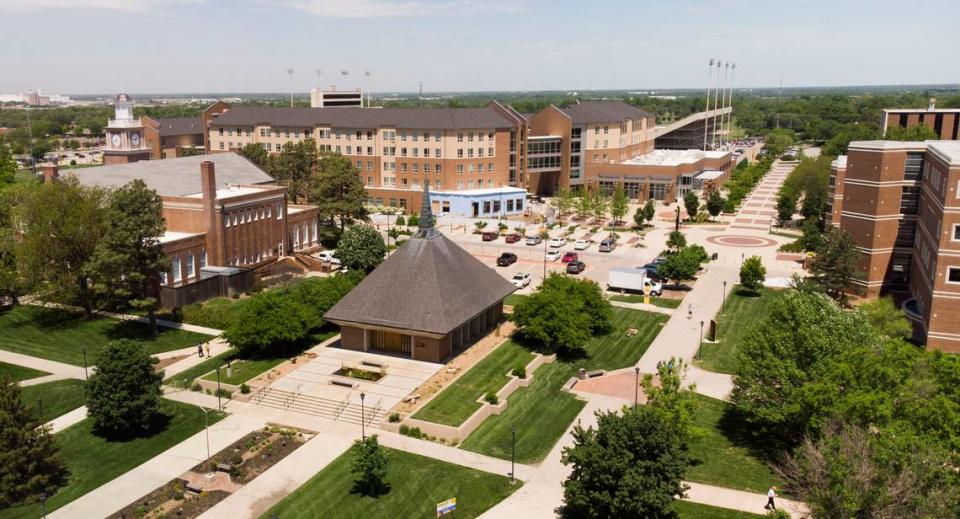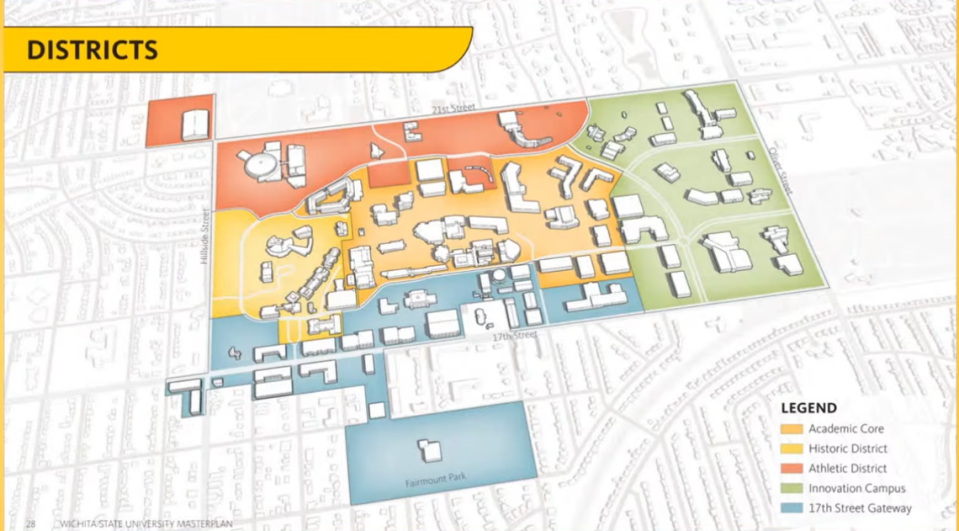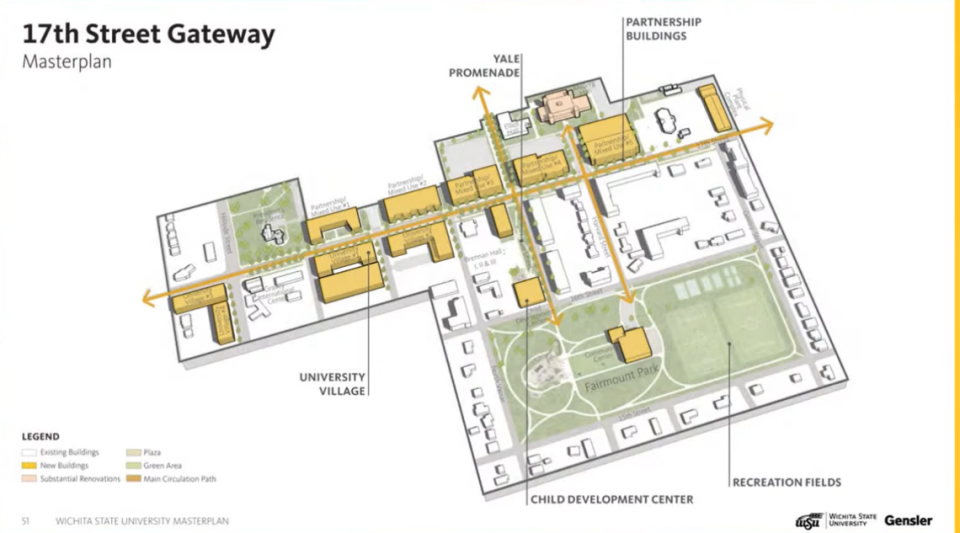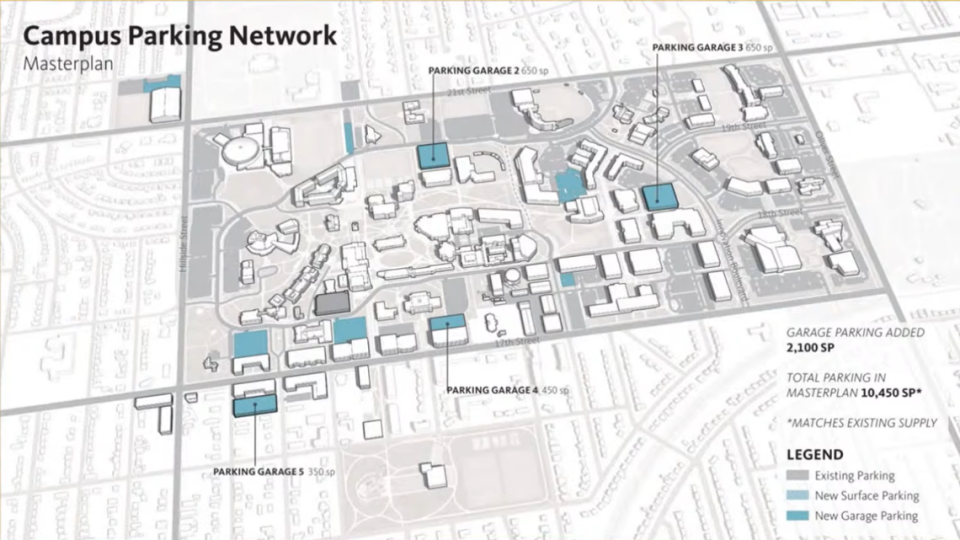Wichita State looks to drastically change campus by 2034. Here’s a glance at the plans
Three months after unveiling a 10-year master plan, Wichita State University has received the green light to make vast changes to its campus.
The 10-year master plan as written includes demolishing over 10 buildings on campus, including Hubbard Hall, Heskett Center, Wilner Auditorium and Neff Hall. Some of the departments in the demolished buildings could be consolidated or moved into existing or future buildings.
The Kansas Board of Regents requires that universities present a master plan every 10 years; WSU’s last was in 2014.
On Thursday, regents unanimously approved the university’s new master plan on a first read after a handful of questions.
One of the questions was about the potential cost.
Emily Patterson, WSU’s executive director of facilities planning, said the university has not put numbers to the plan. President Richard Muma noted that the Innovation Campus’ future buildings could be developed privately, reducing the cost to university stakeholders.
Blake Flanders, president and CEO of the board, asked if those at the university had considered renovating and using existing spaces instead of rebuilding.

In a March 4 meeting about the plan, Patterson said 56 mission-critical buildings on campus require over $150 million in renovations.
Patterson said the university expects to receive $5.5 to $6 million from the state Legislature in educational building fund money, and that money would be better spent on new buildings instead of fighting to repair existing ones.
“By strategically demolishing buildings that are in really poor condition, we’re able to focus that money and better allocate it into the buildings that we’d like to invest in,” Patterson said then.
At the regents meeting on Thursday, Muma echoed this idea; he said that the cost of renovating historic campus buildings like Wilner Auditorium or Hubbard Hall would be astronomical.
“The problem with removing Wilner — it has a lot of deep-seated memories for people … but it just seems almost impossible to make that useful,” Muma said. “And Hubbard is another one to … We pointed that out — how dated that is.”
While some of the conversations focused on potentially saying goodbye to historic buildings, much of Patterson and Muma’s presentation focused on the campus’ future and the hope of creating a stronger sense of community.
Patterson highlighted several buildings in the middle of campus that block pedestrian and car traffic, something university officials hope to change.
“There’s also a clear divide in the center,” Patterson said. “So part of the plan … is to really unify (campus) from a pedestrian perspective.
In preliminary maps, WSU has cleared buildings like Grace Wilkie Annex, the police department, parking services and Wichita State Connect to allow for more recreational and hangout space.
“You can see here there’s large open quads of space that are created by removing some of those low-density … buildings,” Patterson said. “They’re small one-story buildings that can be put into other structures as we move forward.”
With the demolition of these buildings, maps show the addition of a dozen or more buildings, such as a new recreation center, additional academic buildings and more.
Unveiling the plan
When unveiling the master plan to the WSU community in March, Muma said changes wouldn’t happen immediately and could take several years.
“Don’t worry; we won’t tear a building down without identifying a replacement,” he said on March 1.
Architectural firm Gensler is aiding Wichita State in its plans to reconstruct its 128-year-old campus.
Gensler and university employees hosted a virtual event three days after the plan’s unveiling to offer WSU stakeholders a chance to ask questions.
At a March 4 meeting, Steve Wilson, senior associate with Gensler, outlined what Wichita State could look like by 2034, breaking the university’s campus into five districts including an academic core, the Innovation Campus, a gateway between campus and 17th Street, a historic district and an athletic district.

17th Street could see sweeping changes. Wilson said removing Sheldon Coleman Tennis Complex, Brennan Halls I, II, III, and surface-level parking would make room for a “university village.”
This street corridor could be filled with storefronts, cafes, restaurants and more.

“Sort of like a campus town for the university, a Main Street kind of feeling,” Wilson said. “Sort of like a campus town for the university, a Main Street kind of feeling,” Wilson said.
The university now has over 10,000 surface-level parking spots. Building additions would mean the removal of several lots, notably along 17th Street. To replace these, Wilson said the campus could add three or more parking garages.
Wilson did not specify if students would have to pay to park in these garages as they do in the current garage.

Other potential changes to the campus include renovating buildings in need, such as Lindquist Hall, Ablah Library, Jabara Hall and more.
With the master plan approved, its not clear when changes to the campus will begin, but Patterson and Muma said they foresee renovations on Cessna Stadium and Neff Hall being first.
More about the master plan can be viewed on Wichita State University’s YouTube.


